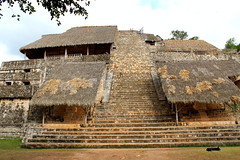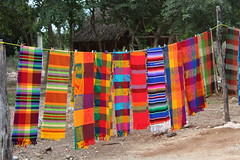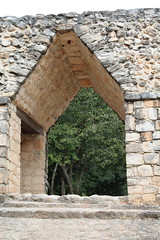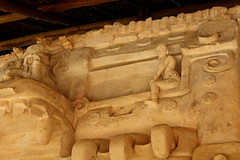 One of the reasons we decided to visit Valladolid was the desire to see the Mayan ruins at Ek’ Balam, located 16 miles north of the city. It is possible to arrange day trips to the ruins from Cancun, Playa del Carmen or Merida. Many of those tours will also include a stop at a nearby cenote but we wanted the chance to spend a few days in “a real Mexican city”, which is the way some Mexican friends described Valladolid so we traveled there independently.
One of the reasons we decided to visit Valladolid was the desire to see the Mayan ruins at Ek’ Balam, located 16 miles north of the city. It is possible to arrange day trips to the ruins from Cancun, Playa del Carmen or Merida. Many of those tours will also include a stop at a nearby cenote but we wanted the chance to spend a few days in “a real Mexican city”, which is the way some Mexican friends described Valladolid so we traveled there independently.
When we asked at our Valladolid hotel front desk for advice in arranging for a taxi for the round trip to visit the ruins at Ek’ Balam, they gave us directions to a stand about 2 blocks away and told us to expect to pay about $250 pesos, which seemed like a very reasonable price. But as we walked in that direction, a cab driver standing beside his car offered a ride to Ek Balam. After a little negotiation we ended up with a deal for a 2-person round trip for $150 pesos, which worked out to be just over $10 for the 32 mile round trip.  When we agreed to the price, the driver asked if we minded if his wife and 2 little kids rode along, which was not a problem.
When we agreed to the price, the driver asked if we minded if his wife and 2 little kids rode along, which was not a problem.
After a drive of about half an hour we were dropped in a nearly empty parking lot at the ruins entrance where there are a few vendors selling souvenirs including textiles. Inside the reception center we bought admittance tickets and then hired a guide for the walk around the ruins.
 Our guide told us that were a couple different possible interpretations for the name Ek’ Balam but the most widely accepted is City of the Dark (black) Jaguar, an animal native to the region. At its height from 770 to 840 AD the city had a population of about 20,000, most of which were farmers and laborers supporting the lifestyle of the royal family and noble class. As you approach the ancient city, you pass by 2 exterior walls. Only the royals and nobles were allowed to live inside of the walls.
Our guide told us that were a couple different possible interpretations for the name Ek’ Balam but the most widely accepted is City of the Dark (black) Jaguar, an animal native to the region. At its height from 770 to 840 AD the city had a population of about 20,000, most of which were farmers and laborers supporting the lifestyle of the royal family and noble class. As you approach the ancient city, you pass by 2 exterior walls. Only the royals and nobles were allowed to live inside of the walls.
After passing by the walls, the first restored structure seen is the Corbeled Mayan Entrance Arch.
The guide told us that there was evidence that Ek’ Balam had interactions with the Mayan cities of Chichen Itza (35 miles to the southwest) and Coba (47 miles to the east). Part of that evidence is a stelae that was found in Chichen Itza similar to the one in the photo below that contained the inscription of the name of an Ek’ Balam king.
Most of the restoration done at the site began in the late 1980s and continued into the 1990s. Compared to Chichen Itza and Coba, Ek’ Balam is not a large city but as we walked around the grounds we saw evidence of a significant number of structures still awaiting restoration.
Among the most interesting structures in Ek’ Balam is an unusual Oval Palace. There is also a courtyard featuring twin facing temples on 2-sides and a well preserved stelae on a third side. In the same general area of the city is a small but nicely restored ball court.
The most impressive structure in Ek’ Balam is a part temple / part palace castillo that is known as the Acropolis. A photo of that is shown at the top of this page. As visitors walk up the 106 steps to the top, they pass some remarkably well preserved stucco covered c arvings that mark tombs on either side of the steps. On the left side of the steps and in the photo to the left is the Jaguar Altar, which is the tomb of King Ukit-Kan-Lek-Tok. On the right side of the steps is a tomb with carvings depicting Winged Mayan Warriors. You may note towards the bottom of the photo to the left are 3 large teeth, which gives the impression that the alter is the face of a jaguar with the opening into the tomb through the animal’s mouth. These two tombs are among the very few areas in Ek’ Balam that are roped off. They are also covered by palapa roofs, which were not original to the structure but in place now for protection from the elements.
arvings that mark tombs on either side of the steps. On the left side of the steps and in the photo to the left is the Jaguar Altar, which is the tomb of King Ukit-Kan-Lek-Tok. On the right side of the steps is a tomb with carvings depicting Winged Mayan Warriors. You may note towards the bottom of the photo to the left are 3 large teeth, which gives the impression that the alter is the face of a jaguar with the opening into the tomb through the animal’s mouth. These two tombs are among the very few areas in Ek’ Balam that are roped off. They are also covered by palapa roofs, which were not original to the structure but in place now for protection from the elements.
The Acropolis is second in height among Mayan structures in the Yucatan to the pyramid in Coba and at our visit in January 2015, visitors are permitted to climb to the top and enjoy the incredible view of the surrounding countryside.
The guided tour takes about an hour but once inside the walls, visitors are free to roam the grounds at their leisure. We probably could have gotten it a little cheaper if we had bargained harder but we paid the guide $40 USD for the tour.
Once we completed our tour, we walked back out to the parking lot where we took the opportunity to buy a cold coconut from a friendly local vendor who offered to cut up the coconut meat when we finished drinking the coconut water.
